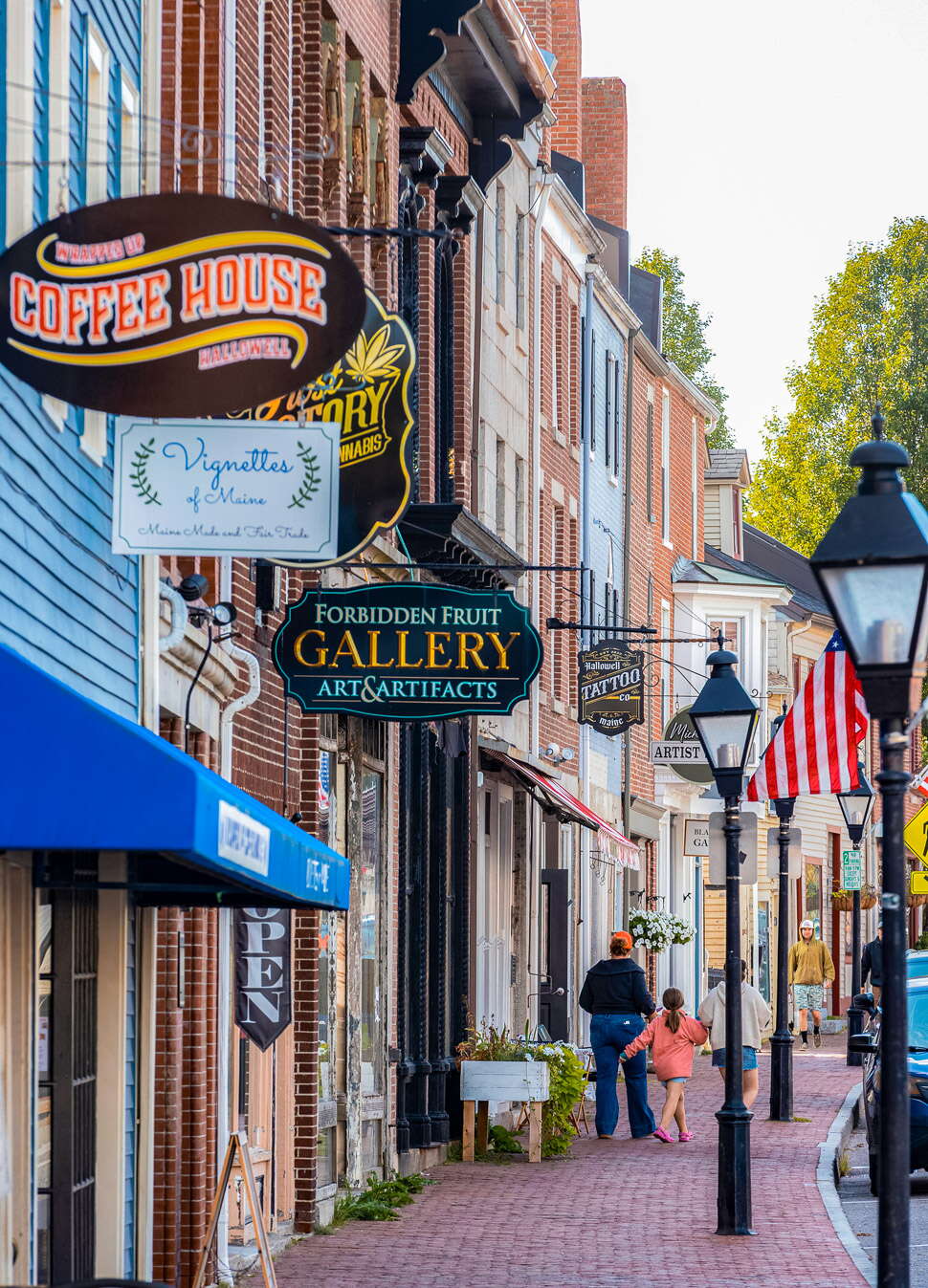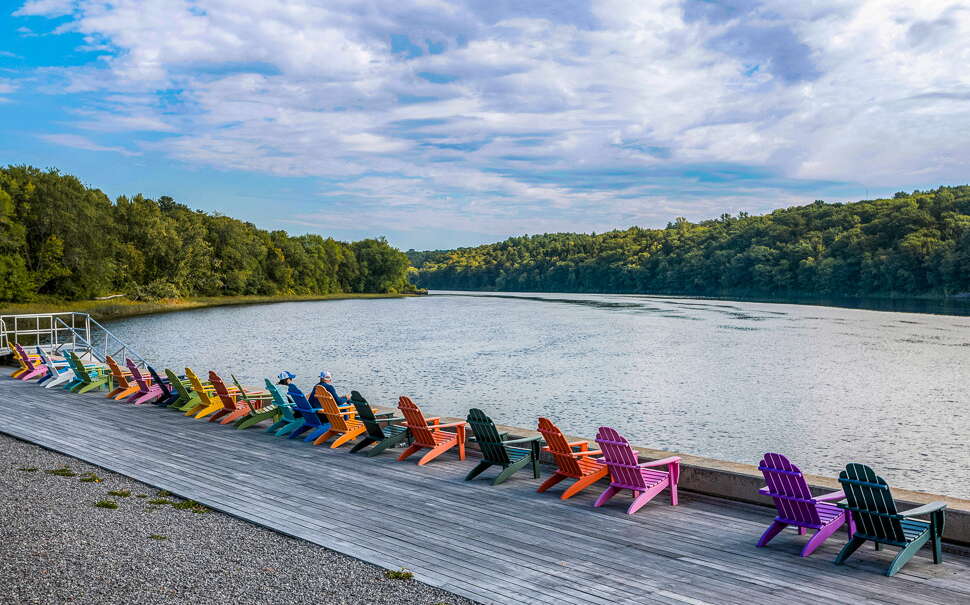
Processing Your Payment
Please do not leave this page until complete. This can take a few moments.
- News
-
Editions
View Digital Editions
Biweekly Issues
- December 1, 2025
- Nov. 17, 2025
- November 03, 2025
- October 20, 2025
- October 6, 2025
- September 22, 2025
- + More
Special Editions
- Lists
- Viewpoints
-
Our Events
Event Info
Award Honorees
- Calendar
- Biz Marketplace
Hallowell thrives while tackling housing, water issues
 Photo / Tim Greenway
Rusticators Emporium is owned by the husband-and-wife team Lexi and Sam Joyall. Sam heads up Vision Hallowell, which works with the Hallowell Board of Trade to keep the downtown vibrant.
Photo / Tim Greenway
Rusticators Emporium is owned by the husband-and-wife team Lexi and Sam Joyall. Sam heads up Vision Hallowell, which works with the Hallowell Board of Trade to keep the downtown vibrant.
At just under six square miles and with a population of barely 2,600, Hallowell is one of Maine’s smallest cities. But along its busy downtown district that hugs the Kennebec River, small is not Hallowell’s vibe.
Water Street’s three-quarter mile retail district is a lively mix of shops, independent businesses, bakeries and restaurants, including the Liberal Cup and Slates, a dining hotspot for more than 40 years.
Augusta is just 2.6 miles north of Hallowell on Route 201. That accounts for some of the traffic through Hallowell, but for many visitors, the capital’s little sister is the destination.
Hallowell is nicknamed the Granite City for its once rich quarries which supplied stone for the Maine State House, Quincy Market in Boston and many buildings in New York including the Metropolitan Museum of Art and the state house in Albany. In Chicago, Hallowell granite built the Marshall Field building and the post office. Shipbuilding, logging and publishing were also thriving industries in the 1800s and early 1900s, but today the hamlet’s primary businesses are focused on tourism and recreation.
For Stephanie Hunter, co-owner of the Quarry Tap Room and director of sales for local retirement community, Granite Hills Estates, the people who live in Hallowell are its greatest asset.
“Hallowell is an amazing town full of artistic, social people who like to contribute to the community,” she says. “It’s a small town with a big heart and everyone always pitches in to help neighbors.”
Music, food and the arts
The city boasts several galleries and the Gaslight Theater — purported to be the state’s longest-operating — located in the restored 127-year-old city hall, just steps up Winthrop Street from the retail strip and the waterfront.

Several restaurants feature live music, and the busy Quarry Tap Room, with seating overlooking the river, has for the past four years hosted Central Maine’s Idol qualifying competitions. Co-owner Chris Vallee just added a teen Idol competition too. The summer concert series Rock on the River has brought an eclectic mix of free performances to town for 30 years.
While music, dining and the arts are major draws for visitors, Hallowell’s year-round residents are what makes the community special in the eyes of Jennifer Heath, a longtime staffer at the Quarry.
“The people here are the kindest,” she says. “If your car broke down, you’d have someone stopping to offer you a ride, a second person calling AAA and a third person calling their brother who owns a garage.”
Evolving retail mix
The mix of shops has changed over time; four new restaurants and stores opened in the past year. Some of the many antiques shops have given way to cafes and gift shops, and a favorite grocery store, Boynton’s Market, closed. But the market’s former location is now home to Rusticators Emporium, Sam and Lexi Joyall’s eclectic antiques, home decor and collectibles shop at 151 Water St.
Sam Joyall heads up Vision Hallowell, one of the primary organizations along with the Hallowell Board of Trade, that works to keep the downtown vibrant.
“There is a lot of community spirit here,” he says. “We have a lot of fun.”
Annual events include Old Hallowell Day in July and the Fall Festival, which features a city-wide display of handmade scarecrows. Parades for Pride Day in June and the Mardi Gras Festival in March draw big crowds.
The Kennebec Valley Chamber of Commerce also helps spur visitation, having relocated to Hallowell from Augusta last year, and the Maine Tourism Association is in town now, too.
Tony Cameron, the association’s CEO, says Hallowell is becoming more popular for visitors who seek “the less busy side of Maine. It’s a bit off the beaten track.”
The Augusta draw
The capital city is just a five-minute drive north, so close in fact that some locals walk or bike to work in Augusta along the 6.5-mile Kennebec River Rail Trail, a riverside parkway that runs from Gardiner all the way to Augusta’s waterfront park.
Hallowell’s own waterfront park, Granite City Park, is a popular spot for sunbathing and fishing — or just watching the sturgeon jump — from a boardwalk lined with colorful Adirondack chairs. The venue also hosts concerts and other events.
The Kennebec River has wreaked havoc on Hallowell though over the years, devastating the downtown with floodwaters, most recently in December 2023 with the so-called Grinch Storm. State and federal funds helped facilitate repairs and businesses were able to function again but no one is confident they’ve seen the last of the river’s rise.
Up above Water Street
Most of the city’s homes sit well above the waterfront, along hilly, tree-lined neighborhoods of remarkably handsome historic homes. Hallowell is a treasure trove of preserved 18th and 19th century architecture; many of its structures are on the National Register of Historic Places.
There’s a homestead museum, tucked into the popular 200-acre Vaughan Woods park, which has three miles of walking trails, stone bridges and waterfalls.

The Gothic-style Hubbard Free Library, the oldest in the state, was built in 1880 to resemble an English church and is a commanding presence on Second Street, just one block up from the retail district. It’s a popular destination in this very walkable city.
Yet Hallowell also faces some of the same challenges seen throughout Maine: the need for housing, particularly rental housing. And the water supply is tainted by contamination from PFAS.
Housing challenges
Hallowell needs more housing.
“There’s a scarcity, particularly for rentals,” says Katie McAllister, a local real estate broker. “It’s becoming more of a buyers’ market here, and we see one to two new listings every week. But we need more rentals.”
Matt Morrill is doing his part. His Mastway Development, based in town, has been building and renovating in Hallowell for years and just moved tenants into Morrill’s latest housing project, a 17-unit affordable apartment building on Beech Street in Stevens Commons, up the Winthrop Street hill from the downtown.
Tree Tops is for households earning up to 80% of the area median income. Rents start at $1,311 for the 550-square-foot one-bedrooms, all utilities included. There are two larger units, topping out at 970 square feet.
Morrill also has under construction, with Augusta-based LaJoie Brothers, a 20-unit condo neighborhood, Ledge Point, and he’s continuing to add to his 15-lot single-family home subdivision, Hallowell Overlook.
He purchased the 63-acre Stevens Commons property in 2016 for $215,000 and he’s invested $20 million more to make the complex what it is today. Once home to a girls’ school and later state offices, the site was abandoned by 2015.
Morrill tore down two buildings, renovated seven more, and three of the buildings are now dormitories for the Univ. of Maine Augusta. He’ll start building a fourth dorm next spring — 62 rooms plus a cafeteria.
The property has a central park-like green which hosts a weekly farmers’ market as well as other local events. Nellie’s Kitchen restaurant is also onsite, and the property is a popular destination for locals.
Mastway has recently built affordable housing in Augusta and has a 32-unit apartment building underway in Gardiner, but Morrill says it’s increasingly difficult to cover development costs, even with subsidies. “Building something that’s affordable is really hard to do now.”
Water contamination
Despite its abundant charms, Hallowell is not immune to challenges.
Like many towns in Maine, it’s wrestling with PFAS contamination to the drinking water, which was first detected in 2022. The new treatment plant needed to address the problem will cost $10 million.
Zach Lovely, superintendent of the Hallowell Water District, says the city’s water comes from an aquifer across the Kennebec in Chelsea, which is partially replenished with river water and that’s contaminated with PFAS from upstream sources, largely municipal sludge which was once a common fertilizer for agriculture.
“It’s not just Hallowell, the chemicals are everywhere, and have been for 80 years,” Lovely says.
The water district has trialed four different treatment options. “We started early in 2024. It’s cost a lot of money and a lot of time, but we want to do it right,” Lovely says.
“Augusta will be ahead of us on this, because they already have a treatment plant that they can add onto. We have to build new.”
Engineers from Topsham-based Wright & Pierce are handling design for a water-treatment system. An EPA grant for $8.2 million will cover much of the $10 million cost.
The city hopes to borrow the rest, but Lovely says project costs could be reflected in residents’ rates. Two-thirds of Hallowell households use city water. Those on private wells might also see contamination, and testing runs as high as $475.
Construction is targeted for 2027, two years ahead of the new EPA standards going into effect. With so many other towns requiring new or updated treatment facilities, lining up contractors is not easy.
Striking a balance
Beyond the PFAS remediation and need for more housing, the biggest challenge newly hired city manager Ross McLellan sees is balancing city services with property taxes.
The median household income for Hallowell was $58,811 in 2023, according to U.S. Census figures; the median age was 49.8. The population is a mix of older residents and families.
Residents were outraged over a tax hike last year, which increased the mil rate by close to 20%. For FY 2026, City Council cut the municipal budget by 15%, to $3.2 million, and set a mil rate of $18.80.
Hallowell has just four police officers and its own public works department; which is a bit uncommon for such a small city. But McLellan says local control saves money over contracting for services and dramatically improves response times on projects.
“The city does a lot with a small budget and small staff,” McLellan says.
Mainebiz web partners

The Giving Guide
The Giving Guide helps nonprofits have the opportunity to showcase and differentiate their organizations so that businesses better understand how they can contribute to a nonprofit’s mission and work.
Learn More
Work for ME
Work for ME is a workforce development tool to help Maine’s employers target Maine’s emerging workforce. Work for ME highlights each industry, its impact on Maine’s economy, the jobs available to entry-level workers, the training and education needed to get a career started.
Learn More
Groundbreaking Maine
Whether you’re a developer, financer, architect, or industry enthusiast, Groundbreaking Maine is crafted to be your go-to source for valuable insights in Maine’s real estate and construction community.
Learn more-
The Giving Guide
The Giving Guide helps nonprofits have the opportunity to showcase and differentiate their organizations so that businesses better understand how they can contribute to a nonprofit’s mission and work.
-
Work for ME
Work for ME is a workforce development tool to help Maine’s employers target Maine’s emerging workforce. Work for ME highlights each industry, its impact on Maine’s economy, the jobs available to entry-level workers, the training and education needed to get a career started.
-
Groundbreaking Maine
Whether you’re a developer, financer, architect, or industry enthusiast, Groundbreaking Maine is crafted to be your go-to source for valuable insights in Maine’s real estate and construction community.
ABOUT
NEW ENGLAND BUSINESS MEDIA SITES
No articles left
Get access now
In order to use this feature, we need some information from you. You can also login or register for a free account.
By clicking submit you are agreeing to our cookie usage and Privacy Policy
Already have an account? Login
Already have an account? Login
Want to create an account? Register
Get access now
In order to use this feature, we need some information from you. You can also login or register for a free account.
By clicking submit you are agreeing to our cookie usage and Privacy Policy
Already have an account? Login
Already have an account? Login
Want to create an account? Register






0 Comments